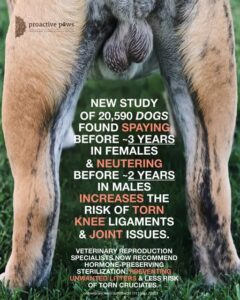Neutering Dogs: Yes or No?
One of the most frequent questions asked of late by our puppy people here at Meisterhunde Rottweilers is if they should or should not neuter or spay their dog, as everyone in the dog industry has an opinion about this.
Below are some compiled articles and abstracts printed with permission on this subject so please read.
If you ask your vet, local shelter or Animal control service they will all say yes. Neutering animals is an important income stream for many vets, which is why so many vets will advise you to neuter
I agree with their philosophy if you only look at neutering or spaying as an overpopulation prevention method and to keep inbreeding and backyard breeding under control. If you would ask your local veterinarian what to do he will surely tell you to neuter or spay your dog. His advice will be health or temperament motivated. In my opinion it is more dollar motivated than anything else.
Many reasons will be mentioned to do this. The most common used is that it will control or even eliminated aggression or dominance in dogs. The reality is that this will only be true in a very small percentage of dogs, and in fact it can go the other way.
Owners for years thought that neutering would cure dominance or aggression problems if the neutering was done before 1 year of age. Many including myself have since learned that I was dead wrong.
I used to believe that neutering would prevent older male dogs from developing prostate problems. Studies have since proven me wrong on that issue too. I use to think it will stop males from cocking his leg and peeing on everything, I was wrong there also.
Dogs that are born with one testicle should be neutered but not until they are 2 years old. If these dogs are not neutered they run the risk of developing testicular cancer at about 5 years of age. Neutering before 2 years is going to affect the dogs fight drive and working ability. Neutering after 2 years is not going to affect the dogs working ability.
Lots of new information is coming to light and professionals have now come to believe that neutering our dogs causes so many health issues with the dogs that it’s simply not worth the risk.

Further thoughts & new studies by other professional have revealed the following…
Cardiac Tumours
A Veterinary Medical Database search of the years 1982 to 1999 revealed that in dogs with tumours of the heart, the relative risk for spayed females was over four times that of intact females.
For the most common type of cardiac tumour, hemangiosarcoma (HAS), spayed females had a greater than five times risk vs. their intact counterparts. Neutered male dogs had a slightly higher risk than intact males.
The study concluded that, “… neutering appeared to increase the risk of cardiac tumour in both sexes. Intact females were least likely to develop a cardiac tumour, whereas spayed females were most likely to develop a tumour. Twelve breeds had greater than average risk of developing a cardiac tumour, whereas 17 had lower risk.”
Bone Cancer
In a study of Rottweilers published in 2002, it was established the risk for bone sarcoma was significantly influenced by the age at which the dogs were sterilised.
For both male and female Rotties spayed or neutered before one year of age, there was a one in four lifetime risk for bone cancer, and the sterilised animals were significantly more likely to develop the disease than intact dogs of the same breed.
In another study using the Veterinary Medical Database for the period 1980 through 1994, it was concluded the risk for bone cancer in large breed, purebred dogs increased twofold for those dogs that were also sterilised.
Prostate Cancer
It’s commonly believed that neutering a male dog will prevent prostatic carcinoma (PC) – cancer of the prostate gland.
This was a small study of just 43 animals, however. And researchers conceded the development of prostate cancer in dogs may not be exclusively related to the hormones produced by the testicles. Preliminary work indicates non-testicular androgens exert a significant influence on the canine prostate.
Abnormal Bone Growth and Development
At puberty, oestrogen promotes skeletal maturation and the gradual, progressive closure of the epiphyseal growth plate, possibly as a consequence of both oestrogen-induced vascular and osteoplastic invasion and the termination of chondrogenesis.
In addition, during puberty and into the third decade, oestrogen has an anabolic effect on the osteoblast and an apoptotic effect on the osteoclast, increasing bone mineral acquisition in axial and appendicular bone.
It appears the removal of oestrogen-producing organs in immature dogs, female and male, can cause growth plates to remain open. These animals continue to grow and wind up with abnormal growth patterns and bone structure. This results in irregular body proportions.
According to Chris Zink, DVM:
“For example, if the femur has achieved its genetically determined normal length at 8 months when a dog gets spayed or neutered, but the tibia, which normally stops growing at 12 to 14 months of age, continues to grow, then an abnormal angle may develop at the stifle. In addition, with the extra growth, the lower leg below the stifle likely becomes heavier (because it is longer), and may cause increased stresses on the cranial cruciate ligament.”
Higher Rate of ACL Ruptures
A study conducted on canine anterior cruciate ligament (ACL) injuries concluded that spayed and neutered dogs had a significantly higher incidence of ACL rupture than their intact counterparts. And while large breed dogs had more ACL injuries, sterilized dogs of all breeds and sizes had increased rupture rates.
Hip Dysplasia
In a retrospective cohort study conducted at Cornell University’s College of Veterinary Medicine, and published in the Journal of the American Veterinary Medical Association, results showed that both male and female dogs sterilised at an early age were more prone to hip dysplasia.
Other Early-Age Spay/Neuter Health Concerns
Noise phobias
Fearful behaviour
Aggression
Undesirable sexual behaviours
Please note:
There is no perfect answer to the spay/neuter question that fits every pet, and each situation should be handled individually. Desex only if a serious health issue is at hand.
For Responsible Pet Owners, Decisions about When to Spay or Neuter Should be Part of a Holistic Approach to Your Pet’s Health and Quality of Life
If you own an intact pet, I can offer a general guideline for timing a spay/neuter procedure.
Your dog should be old enough to be a balanced individual both physically and mentally, this in most large breeds is 18 to 24 months of age. Although some breeds reach maturity faster than others.
Other considerations include your dog’s diet, level of exercise, behavioural habits, previous physical or emotional trauma, existing health concerns, and overall lifestyle.
If you own an intact animal and need to make a spay/neuter decision, I encourage you to first learn all you can about surgical sterilisation options and the risks and benefits associated with the procedures.


















































